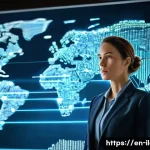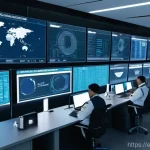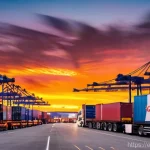Alright, fellow logistics warriors! If you’re wrestling with the intricate world of international shipping, you know firsthand that customs procedures aren’t just a hurdle – they can feel like an Olympic-level obstacle course.
I’ve spent years navigating these waters, and believe me, the landscape is changing faster than ever, often with new regulations and tariffs surprising us.
Think about it: unprecedented geopolitical disruption, the continuous rise of e-commerce, and the ever-present push for sustainability are all reshaping how we move goods across borders, demanding hyper-vigilance and a proactive strategy.
Suddenly, what used to be routine paperwork now requires a deep understanding of complex regulations and a constant monitoring of preferential treatments under various free trade agreements to ensure optimal benefits.
You might be wondering how to keep up with evolving regulations, avoid costly delays, and ensure your shipments glide through without a hitch. It’s more than just compliance; it’s about optimizing your entire supply chain for efficiency and profitability in a world that demands speed and transparency.
With customs authorities increasingly leveraging AI for targeted surveillance and anticipating a paperless trade environment, leveraging technology isn’t just an option—it’s becoming a strategic imperative for seamless operations and risk mitigation.
Stick around because I’m going to share some game-changing insights that will help you turn customs from a challenge into a competitive advantage. Let’s accurately find out!
Navigating the Maze of Trade Agreements and Tariffs

Understanding Preferential Treatment
You know, it’s not enough to just ship goods anymore; you need to be a tariff wizard! I remember a client who almost left a huge sum of money on the table because they weren’t fully leveraging the North American Free Trade Agreement (NAFTA), which then evolved into the USMCA.
The sheer volume of free trade agreements (FTAs) out there – from the CPTPP to the EU’s various bilateral deals – can be overwhelming, but understanding the nuances of preferential treatment is absolutely critical for cost savings.
My personal experience has shown me that a thorough review of your product’s eligibility under these agreements can uncover significant duty reductions, directly impacting your bottom line.
It’s not just about knowing the agreement exists; it’s about delving deep into the rules of origin and specific product requirements. Overlooking these details is like leaving cash on the table, and who wants to do that?
Each agreement has its own quirks, and what works for one might not apply to another, demanding meticulous attention to detail from your team. This level of detail-orientation not only helps you save money but also positions you as a strategic partner to your clients, demonstrating your expertise in a competitive global landscape.
It’s about turning complexity into a competitive advantage, making your logistics operations not just efficient but also financially astute.
Impact of Geopolitical Shifts on Trade Lanes
If there’s one thing I’ve learned in this industry, it’s that the world never stands still. Geopolitical events, from trade wars to sudden policy changes in key economic blocs, can instantly reshape your shipping strategy.
I’ve personally seen how quickly tariff rates can skyrocket or specific goods become subject to new restrictions overnight. Remember the shifts during the U.S.-China trade tensions?
Companies that were agile enough to pivot their sourcing or reroute their supply chains were the ones who stayed afloat, while others faced immense financial pressure.
It’s no longer enough to just monitor news headlines; you need a dedicated team or a robust system constantly tracking these global shifts and their potential impact on your specific goods and target markets.
The ability to anticipate these changes, or at least react swiftly, is what separates the thriving logistics partners from those struggling to keep up.
This proactive approach includes scenario planning: what if a key trading partner implements new tariffs? What if a crucial port faces sanctions? Having answers to these questions before they become reality is a game-changer for maintaining supply chain resilience and ensuring your clients’ cargo keeps moving.
It’s all about strategic foresight and the ability to adapt at lightning speed to protect your operations and your clients’ interests.
Embracing Technology for Seamless Customs Compliance
Leveraging AI and Automation in Customs Declarations
Honestly, if you’re still manually inputting every customs declaration, you’re playing yesterday’s game. The future, and frankly, the present, is all about AI and automation.
I’ve witnessed firsthand how integrating intelligent software can drastically reduce errors and accelerate the entire declaration process. Think about it: an AI-powered system can sift through vast amounts of data, cross-reference regulations, and even flag potential compliance issues before they become costly problems.
It’s like having a super-smart customs officer working for you 24/7. Not only does this save countless hours of tedious work, but it also dramatically improves accuracy, which is paramount when dealing with customs authorities.
I’ve seen companies cut their processing times by more than half, freeing up their valuable human resources to focus on more complex, strategic tasks rather than repetitive data entry.
This shift isn’t just about efficiency; it’s about transforming your customs operations from a bottleneck into a smooth, streamlined flow, giving you a competitive edge in speed and reliability.
Data Analytics for Predictive Compliance
Beyond just automating declarations, the real magic happens when you start leveraging data analytics for predictive compliance. This is where you move from reactive problem-solving to proactive risk mitigation.
By analyzing historical shipment data, customs decisions, and global trade trends, you can identify patterns and anticipate future challenges. For example, my team once used analytics to predict which types of shipments were most likely to be flagged for inspection in certain ports, allowing us to proactively prepare additional documentation or adjust routes.
This kind of foresight is invaluable. It’s about using the data you already have to make smarter decisions, reduce potential delays, and avoid penalties.
Imagine being able to predict changes in customs scrutiny for specific product categories or routes – that’s the power of data analytics in action. It’s not just about crunching numbers; it’s about extracting actionable insights that safeguard your operations and enhance your reputation as a reliable logistics partner.
Mastering HS Codes and Valuation: Your First Line of Defense
The Art of Accurate Classification
Let’s be real, the Harmonized System (HS) code is the backbone of international trade, and getting it wrong is an express ticket to delays, fines, and even seizure of goods.
I’ve personally seen shipments held up for weeks just because a seemingly minor detail in the HS code was incorrect, leading to a cascade of problems and frustrated clients.
Accurate classification isn’t just a bureaucratic step; it’s a critical skill that directly impacts duties, taxes, and eligibility for preferential treatment.
It requires a deep understanding of your products, their components, and their intended use, often demanding a closer look at technical specifications than you might initially think.
My advice? Don’t skimp on this. Invest in good classification tools, extensive training for your team, and when in doubt, consult with a seasoned customs broker or a classification specialist.
It’s better to spend a little extra upfront to ensure accuracy than to pay a hefty price later in penalties and lost time. This meticulous approach to classification serves as your first and most important line of defense against customs challenges.
Demystifying Customs Valuation Methods
Beyond the HS code, customs valuation is another area where many companies stumble. Determining the correct value of imported goods for duty purposes isn’t as straightforward as just looking at the invoice price.
There are various valuation methods, like transaction value, deductive value, and computed value, each with its own set of rules and required documentation.
I once worked with a company that consistently undervalued their goods, not intentionally, but because they weren’t including certain assists and royalties in their declared value.
This eventually led to a significant customs audit and a hefty bill for back duties and penalties. Understanding Incoterms is crucial here, as they define where the responsibility and costs shift.
My personal take is that a clear, transparent, and defensible valuation method is absolutely essential. You need to be able to justify every component of your declared value, including freight, insurance, and any other costs that might be deemed part of the dutiable value.
Clarity and meticulous record-keeping are your best friends here.
Common Customs Mistakes and How to Avoid Them
There are a few recurring blunders I’ve observed over the years that can turn a smooth shipment into a logistical nightmare. It’s often the small details that trip people up, but the consequences can be anything but small.
From misinterpreting trade agreement clauses to simply missing a crucial document, these mistakes are entirely avoidable with the right processes and vigilance.
I’ve even seen companies struggle with something as basic as inconsistent descriptions across different documents, which immediately raises red flags for customs officials.
It truly boils down to thoroughness and a commitment to continuous learning within your organization.
| Mistake | Impact | How to Avoid |
|---|---|---|
| Incorrect HS Code Classification | Delays, Fines, Incorrect Duties, Potential Seizure | Invest in professional classification software, regularly train staff, seek expert advice and obtain binding rulings. |
| Inaccurate Valuation of Goods | Underpayment/Overpayment of Duties, Customs Audits, Penalties | Understand Incoterms, maintain detailed transaction records, clarify all costs, and document your valuation methodology. |
| Missing or Incomplete Documentation | Shipment Holds, Penalties, Customs Seizure, Delivery Delays | Utilize digital document management, create pre-shipment checklists, ensure all parties submit on time, and verify completeness. |
| Lack of Compliance with Partner Government Agencies (PGAs) | Product Detentions, Legal Issues, Market Access Restrictions | Identify all relevant PGAs (e.g., FDA, EPA, USDA), understand their specific import requirements, and verify product compliance before shipping. |
| Poor Record-Keeping | Difficulty Defending Against Audits, Penalties, Loss of Privileges | Implement a robust record-keeping system for at least 5-7 years, covering all import/export transactions and supporting documentation. |
Risk Management and Audits: Staying Ahead of the Curve
Proactive Internal Audits
In the world of customs, being proactive isn’t just a buzzword; it’s a survival strategy. I can’t stress enough the importance of conducting regular internal audits of your customs processes.
Waiting for a customs authority to audit you is like waiting for a dental emergency – it’s almost always more painful and expensive. By performing your own internal checks, you can identify weaknesses, correct errors, and strengthen your compliance posture *before* they become official discrepancies.
I’ve advised countless clients to treat their internal audits with the same rigor as an external one, reviewing everything from classification accuracy and valuation methods to documentation completeness and record-keeping practices.
It’s an investment in peace of mind and financial security. This approach allows you to demonstrate “reasonable care” to customs authorities, which can significantly mitigate penalties if issues are discovered.
Plus, it fosters a culture of continuous improvement within your team, ensuring everyone stays sharp and informed on the latest regulations.
Responding to Customs Inquiries and Investigations
No matter how diligent you are, there might come a time when customs authorities have questions, or even open an investigation. When that happens, your response strategy is paramount.
Panic is not an option; swift, professional, and well-documented communication is. I’ve seen situations where a calm, organized response, backed by solid records, turned a potentially serious inquiry into a minor clarification.
Conversely, a disorganized or defensive reaction can quickly escalate matters. It’s crucial to understand your rights and obligations, provide only the requested information, and maintain a clear, audit trail of all communications.
If you don’t have in-house expertise, don’t hesitate to engage a customs attorney or a specialized consultant immediately. Their experience in navigating these waters can be invaluable, ensuring you respond effectively and protect your interests without inadvertently digging a deeper hole.
Remember, how you react in these moments defines your credibility and your relationship with regulatory bodies moving forward.
The Green Frontier: Sustainability in Customs and Logistics
Eco-Friendly Logistics and Customs Incentives
It’s no secret that sustainability is no longer just a trend; it’s a fundamental shift in how we do business, and customs is catching up. I’m seeing more and more countries implementing policies that encourage eco-friendly logistics practices, sometimes even offering incentives or preferential treatment for “green” shipments.
This could manifest as expedited clearance for goods transported via sustainable modes, or reduced duties for environmentally friendly products. I remember a project where we helped a client identify opportunities for carbon footprint reduction in their supply chain, which not only aligned with their corporate values but also opened up possibilities for specific customs benefits in certain European markets.
It’s about looking beyond mere compliance and actively seeking out ways to integrate sustainability into your logistics strategy. This isn’t just good for the planet; it’s increasingly good for your bottom line and your brand image in a world where consumers and governments alike demand greater environmental responsibility from businesses.
Reducing Carbon Footprint in Global Shipments
The pressure to reduce carbon emissions across the supply chain is immense, and customs procedures play a subtle yet significant role. Think about the impact of delays: extended dwell times in ports mean more fuel consumption for vessels, more warehousing energy, and increased emissions.
Efficient customs clearance, therefore, directly contributes to a lower carbon footprint by keeping goods moving smoothly. Beyond that, I encourage my clients to explore options like optimizing shipping routes for fuel efficiency, consolidating shipments to reduce individual movements, and leveraging intermodal transport when feasible.
While customs might not directly control these aspects, understanding how your operational choices impact your carbon footprint and how customs incentives align with those choices is vital.
It’s a holistic approach where every decision, from packaging materials to transport modes, contributes to a more sustainable and, often, more cost-effective supply chain.
Engaging with customs brokers who are knowledgeable in green logistics can provide further insights into these evolving opportunities.
Building a Rock-Solid Customs Compliance Team
Training and Professional Development
Let’s face it, your customs compliance is only as strong as the people managing it. The regulations are constantly evolving, new trade agreements emerge, and technology advances.
That’s why continuous training and professional development are non-negotiable. I’ve always advocated for regular workshops, certifications, and access to industry seminars for any team member involved in international trade.
It’s not a one-time thing; it’s an ongoing commitment. I remember a time when a new team member, fresh out of training on a specific FTA, caught a potential duty error that would have cost the company thousands.
That small investment in their education paid dividends almost immediately. Investing in your team’s knowledge isn’t just about avoiding penalties; it’s about empowering them to identify opportunities for efficiency, cost savings, and strategic advantage.
A well-trained team is your best asset in navigating the complex customs landscape, giving you the confidence that your operations are in capable hands.
Leveraging External Expertise (Brokers, Consultants)
While an in-house team is vital, there are times when you absolutely need to tap into external expertise. Customs brokers and trade consultants aren’t just paper pushers; they are invaluable partners who live and breathe customs regulations.
I’ve found that even the most experienced in-house teams can benefit from a fresh pair of expert eyes, especially when dealing with complex or novel shipments, new market entries, or challenging audit scenarios.
Think of them as your strategic advisors, offering insights into regulatory changes, specific commodity classifications, or complex valuation methods that might be outside your daily scope.
For instance, when a client was expanding into a completely new region with unique import restrictions, bringing in a local customs consultant made all the difference, preventing costly missteps.
Building strong relationships with trusted external experts ensures you have a safety net and access to specialized knowledge when you need it most, complementing your internal capabilities and enhancing your overall compliance framework.
Wrapping Things Up
Phew! We’ve covered a lot of ground today, haven’t we? From the intricate dance of trade agreements to the cutting-edge integration of AI in customs, it’s clear that navigating global trade is more dynamic and complex than ever.
My hope is that this deep dive has shed some light on areas you might have found daunting and, more importantly, armed you with practical insights you can immediately put into action.
Remember, customs compliance isn’t just a regulatory hurdle; it’s a strategic advantage waiting to be unlocked. By staying informed, embracing technology, investing in your team, and knowing when to leverage external expertise, you’re not just avoiding pitfalls – you’re building a more resilient, efficient, and profitable supply chain.
It’s an ongoing journey of learning and adaptation, but with the right mindset and tools, you’ll be well-equipped to sail smoothly through the ever-changing tides of international commerce.
A Few Extra Tips for Smooth Sailing
1. Stay Proactively Updated on Global Trade Policies and Agreements: The world of trade is a rapidly shifting landscape, and what’s true today might be different tomorrow. I’ve personally found that subscribing to updates from government trade bodies like the U.S. Trade Representative (USTR), the European Commission’s Directorate-General for Trade, or local chambers of commerce is absolutely invaluable. Don’t just skim headlines; dive into the details of new preferential agreements, evolving sanctions, or changes in product-specific regulations. These updates often contain crucial information that can impact your duty rates, market access, or even the viability of certain trade routes. Setting up automated alerts and dedicating regular time for your team to review these changes can save you from unexpected costs or, worse, stalled shipments. It’s about building a robust intelligence gathering system that keeps you several steps ahead of the curve, ensuring your business is always operating on the most current and advantageous information available.
2. Invest in Comprehensive Compliance Management Software: If you’re still relying on spreadsheets or outdated systems, you’re missing out on a huge opportunity for efficiency and accuracy. Modern customs compliance software can automate everything from HS classification suggestions to duty calculations, and even the generation of complex customs declarations. I’ve seen companies drastically reduce manual errors and processing times by integrating such platforms, which often come with built-in regulatory databases that update automatically. This isn’t just about saving time; it’s about mitigating risk. A good system provides an auditable trail, helps you manage preferential origin claims, and can even flag potential issues before you submit your declarations, acting as an invaluable digital safety net. Think of it as your virtual compliance officer, working tirelessly to keep your operations smooth and penalty-free.
3. Cultivate Strong Relationships with Experienced Customs Brokers: While technology is a game-changer, nothing truly replaces the human element, especially when it comes to the nuances of local customs regulations. A seasoned customs broker is more than just someone who files your paperwork; they are your eyes and ears on the ground, often possessing invaluable local knowledge and relationships that can make all the difference. I’ve found that having a go-to broker who truly understands your products and your business model can be a lifesaver when navigating complex classifications, valuation disputes, or unexpected delays. They can advocate on your behalf, provide critical insights into specific port procedures, and help you interpret regulations that might be ambiguous. Building a partnership based on trust and clear communication with a reputable broker is an investment that consistently pays dividends, acting as a crucial extension of your in-house compliance team.
4. Prioritize Continuous Training and Professional Development for Your Team: The regulatory landscape isn’t static, and neither should your team’s knowledge be. Continuous education is absolutely paramount in customs compliance. Encourage your staff to pursue certifications like the Certified Customs Specialist (CCS) in the U.S. or similar programs in your region, attend industry webinars, and participate in workshops focused on specific trade agreements or compliance areas. I’ve personally witnessed how an investment in training can empower employees to identify cost-saving opportunities or prevent significant compliance breaches. When your team is well-versed in the latest regulations, they become proactive problem-solvers and strategic assets rather than just executors of tasks. It fosters a culture of expertise and vigilance, ensuring that your company’s customs operations are always handled by knowledgeable professionals capable of adapting to new challenges.
5. Leverage Data Analytics for Predictive Compliance and Cost Savings: Beyond simply reporting on past shipments, the real power of data lies in its ability to predict future trends and identify strategic opportunities. By analyzing your historical import/export data – including HS codes, origins, valuations, and customs decisions – you can uncover patterns that inform better decision-making. For example, you might identify which product categories frequently trigger inspections, allowing you to proactively prepare additional documentation, or pinpoint opportunities for duty drawback programs you hadn’t considered. I’ve helped clients use data to optimize their supply chain routes, anticipate changes in customs scrutiny for certain goods, and even negotiate better terms with suppliers by understanding the full cost impact of tariffs. This moves you from reactive problem-solving to proactive risk management and strategic cost optimization, giving you a significant competitive edge in the market.
Your Essential Compliance Checklist
When the dust settles, remember these core principles to keep your global trade operations sharp and compliant. First and foremost, a proactive mindset is your best defense; don’t wait for issues to arise – anticipate them, audit internally, and stay informed.
Secondly, knowledge truly is power, especially when it comes to mastering HS codes and understanding valuation methods. Getting these foundational elements right will save you countless headaches and dollars.
Thirdly, embrace technology; AI and data analytics aren’t just buzzwords, they’re indispensable tools for efficiency, accuracy, and predictive insights.
Finally, invest in your people and leverage external expertise; a well-trained internal team, complemented by trusted customs brokers and consultants, forms an unshakeable compliance framework.
By consistently applying these principles, you’re not just meeting regulatory obligations; you’re building a resilient, strategic, and ultimately more profitable international business.
Frequently Asked Questions (FAQ) 📖
Q: How can businesses realistically keep up with the constant flux of international customs regulations without getting overwhelmed?
A: Honestly, it feels like trying to hit a moving target sometimes, doesn’t it? The best defense here is a good offense, and that means staying incredibly proactive.
Personally, I’ve found a multi-pronged approach works wonders. First, subscribe to reputable trade publications and government alerts. Organizations like the World Customs Organization (WCO) or even your local Chamber of Commerce often publish updates that are golden.
Don’t underestimate the power of a solid customs broker either; they live and breathe this stuff, and a good one is worth their weight in gold, especially with ever-changing tariff codes and new geopolitical shifts impacting trade agreements.
Also, consider investing in robust customs management software. These platforms are becoming incredibly smart, often flagging potential issues before they even become a problem and helping you navigate complex preferential treatment rules under various Free Trade Agreements.
I’ve seen firsthand how a well-informed team, backed by smart tech, can pivot quickly when regulations shift, turning potential headaches into seamless transitions.
It’s less about knowing everything yourself and more about building a reliable ecosystem to keep you informed and agile.
Q: What are some common, yet often overlooked, mistakes that lead to costly delays or penalties in customs, and how can we truly avoid them?
A: Oh, where do I even begin? I’ve seen countless shipments held up, sometimes for weeks, over things that seem minor but carry a huge punch. The biggest culprit, in my experience, is often incorrect or incomplete documentation.
We’re talking about everything from misclassifying Harmonized System (HS) codes – a slight slip here can mean a completely different duty rate or even outright prohibition – to inaccurate valuations, which can trigger audits faster than you can say “customs inspection.” Another huge one?
Underestimating the power of Incoterms. Choosing the wrong Incoterm can totally shift responsibilities and costs, leading to nasty surprises down the line.
I once dealt with a situation where a company paid demurrage charges for weeks because they didn’t fully grasp their responsibilities under a specific Incoterm.
Also, neglecting pre-clearance preparation is a common blunder. In today’s fast-paced world, waiting until the goods arrive at the border is just asking for delays.
Proactive data submission and ensuring all necessary licenses and permits are in order before shipment can save you a mountain of stress and money. Trust me, a little extra scrutiny upfront goes a long, long way in avoiding those painful, profit-eroding delays.
Q: With all this talk about
A: I and paperless trade, how can companies actually use technology to turn customs compliance into a competitive advantage, rather than just a headache?
A3: This is where things get really exciting, and honestly, if you’re not thinking about this, you’re already behind the curve. Technology isn’t just about making things easier anymore; it’s about making them smarter and giving you a genuine edge.
I’ve personally witnessed businesses transform their operations by embracing tools beyond basic spreadsheets. Think about AI-driven analytics: it can sift through mountains of trade data, spot trends in tariffs, identify optimal routes, and even predict potential compliance risks before they manifest.
Imagine getting real-time alerts about a changing regulation that might impact your specific product line – that’s powerful! Then there’s customs management software (CMS) that automates document generation, verifies data against regulations, and helps you optimize for duty drawbacks or preferential trade agreements.
My favorite part is the enhanced visibility. With blockchain-enabled supply chains and advanced tracking, you get an unparalleled level of transparency from origin to destination, which not only builds trust with customs authorities (hello, faster clearances!) but also helps you make more informed decisions across your entire logistics network.
It’s not just about removing paper; it’s about having a lean, agile, and incredibly intelligent customs operation that ultimately boosts your bottom line and keeps you ahead of the competition.
📚 References
Wikipedia Encyclopedia
구글 검색 결과
구글 검색 결과
구글 검색 결과
구글 검색 결과
구글 검색 결과






